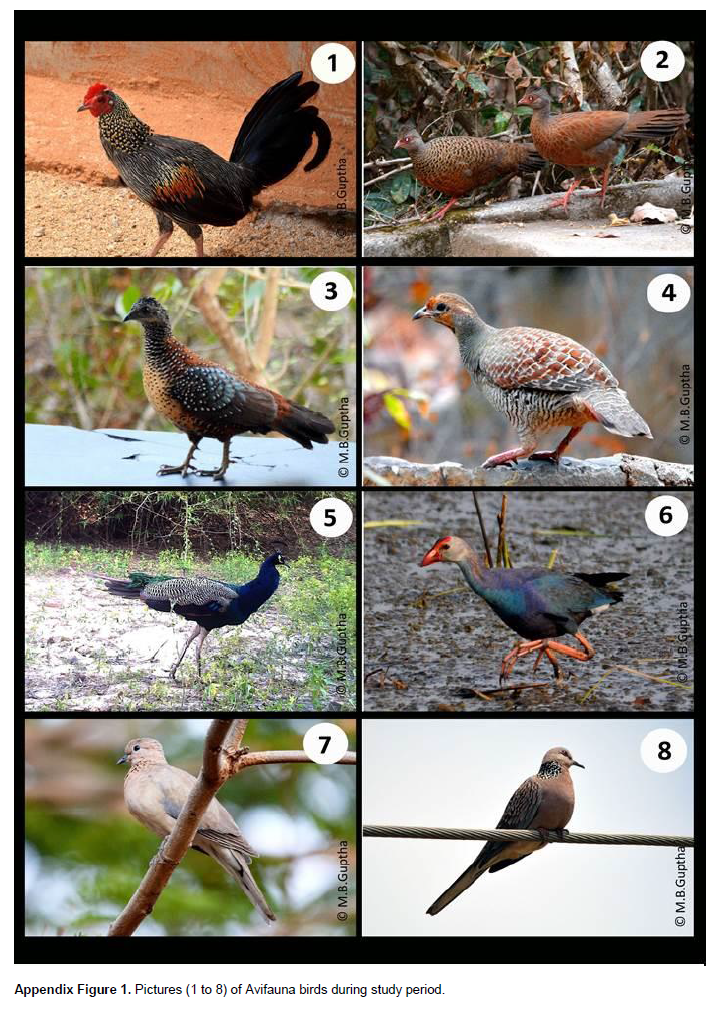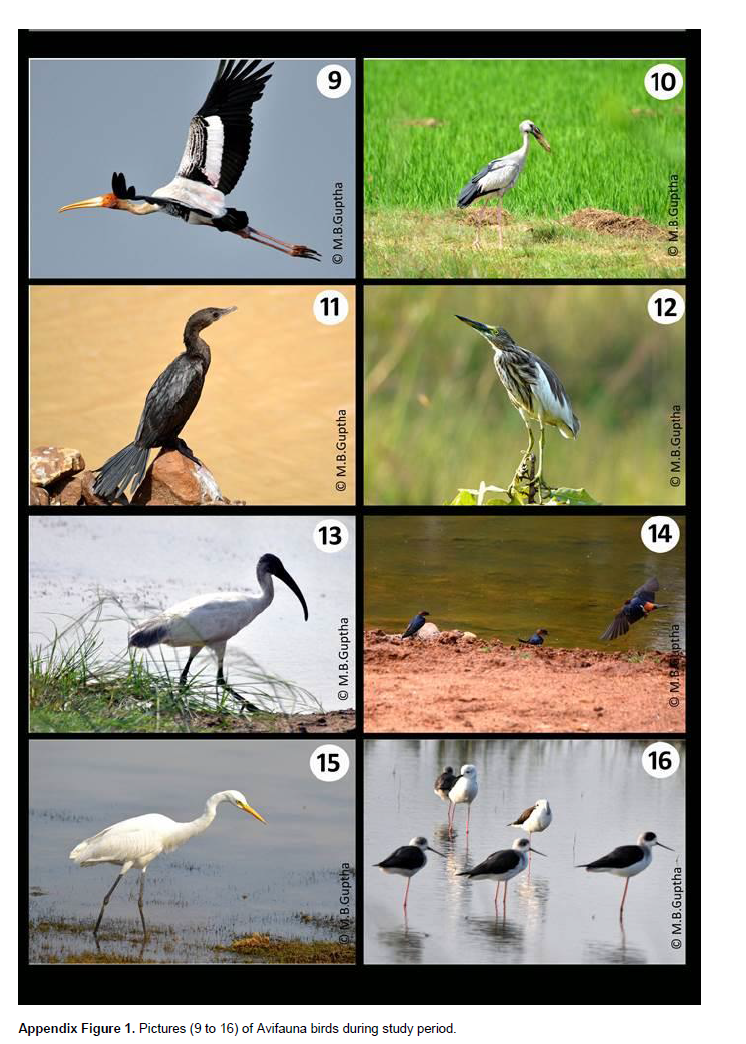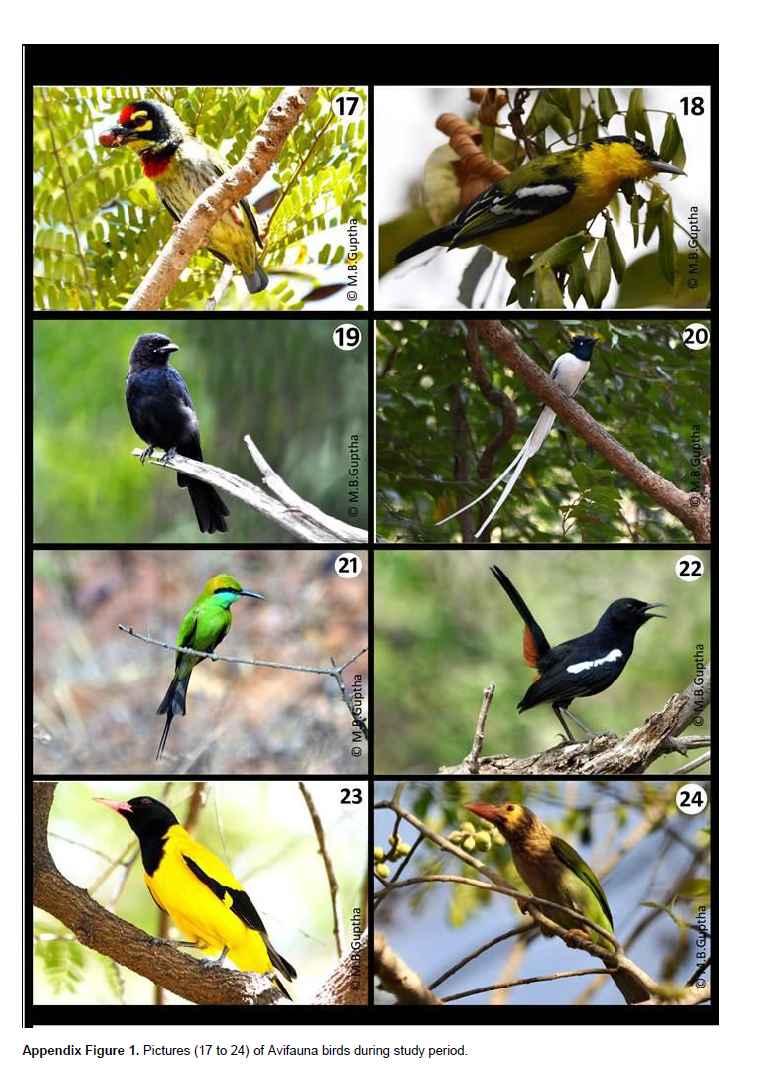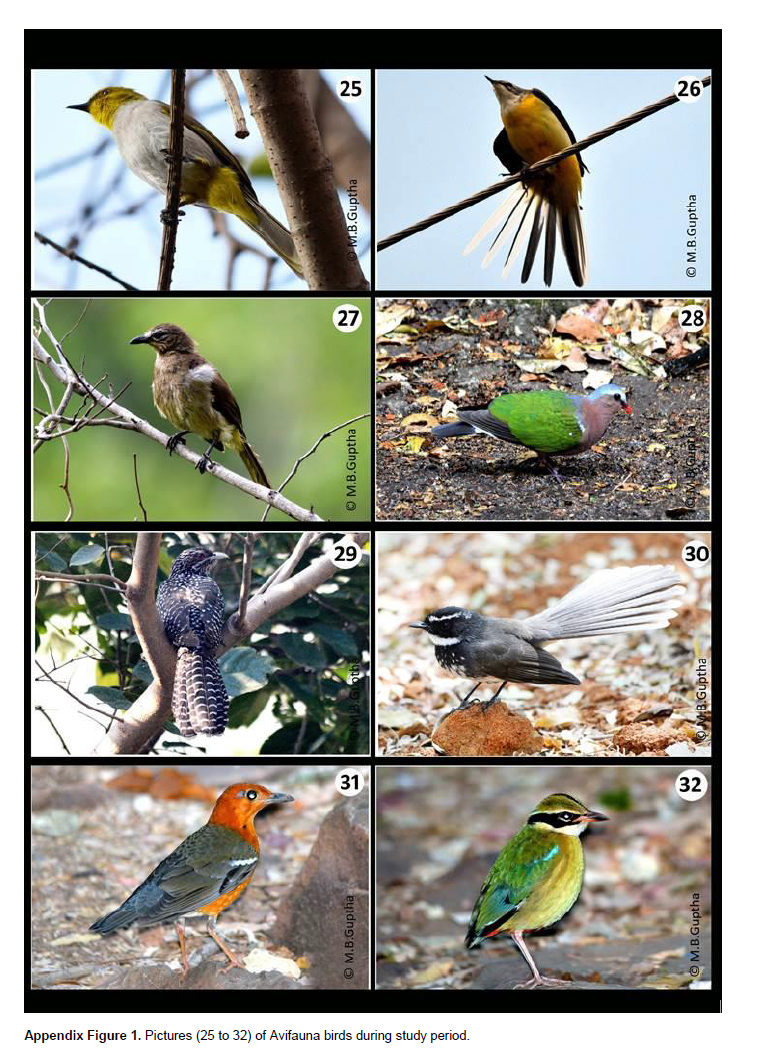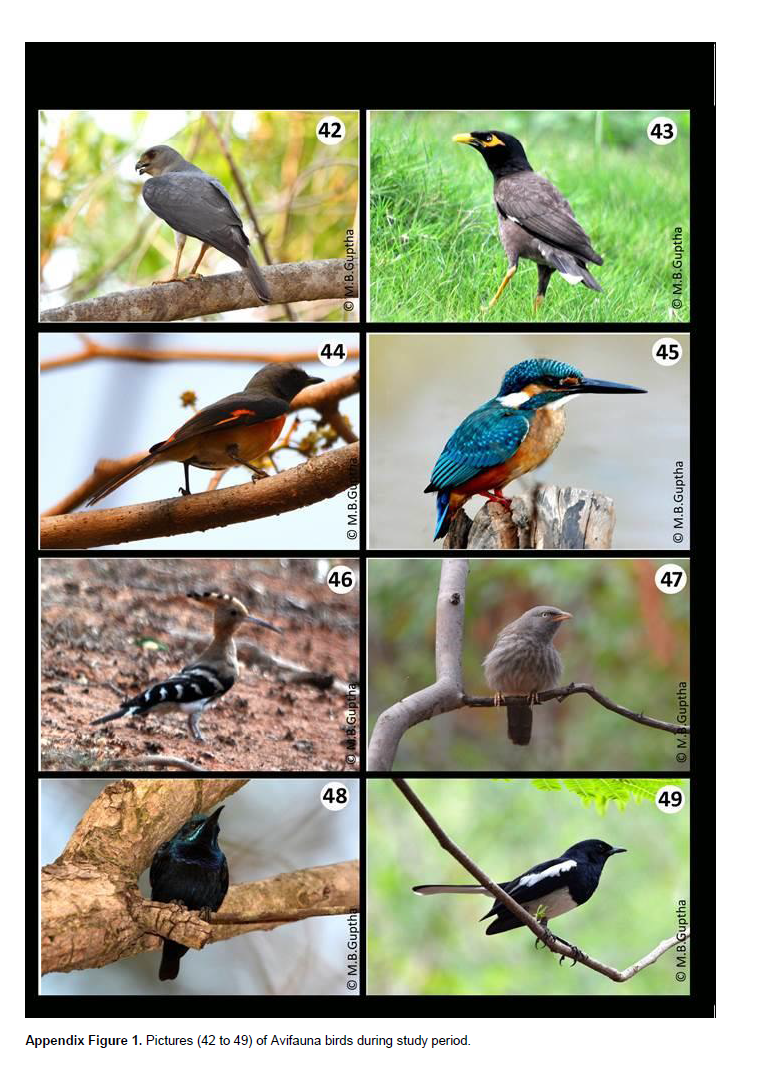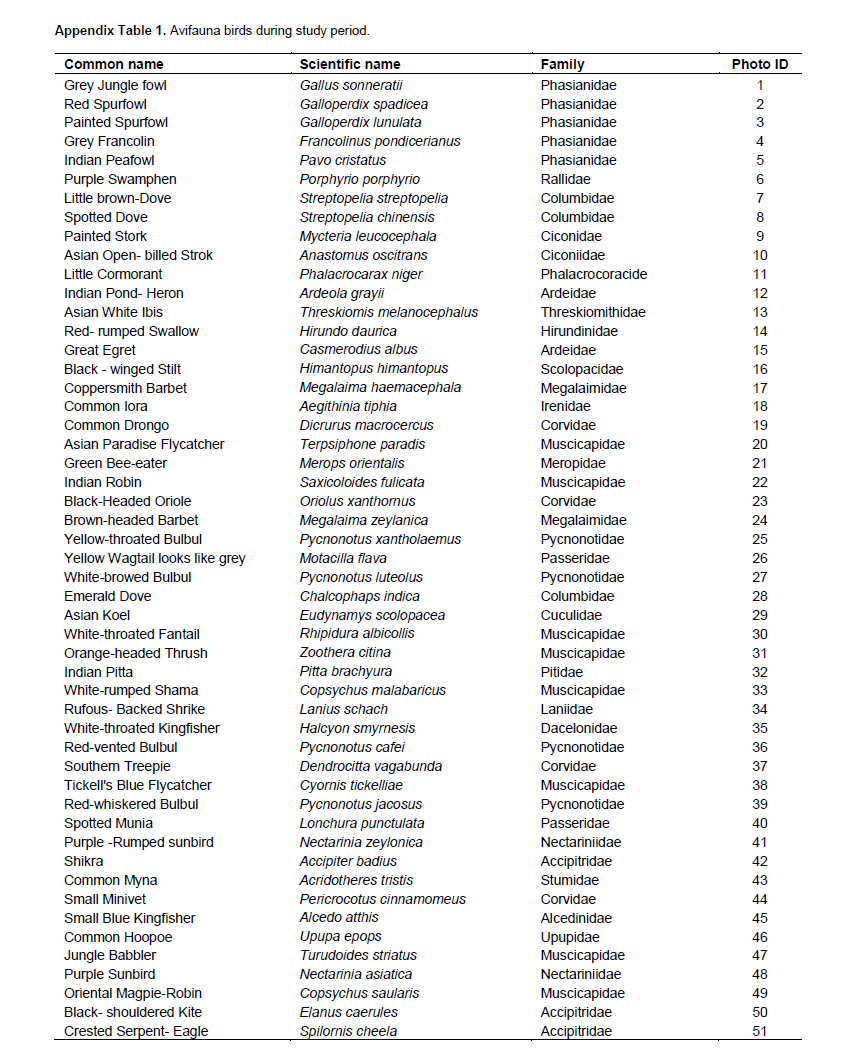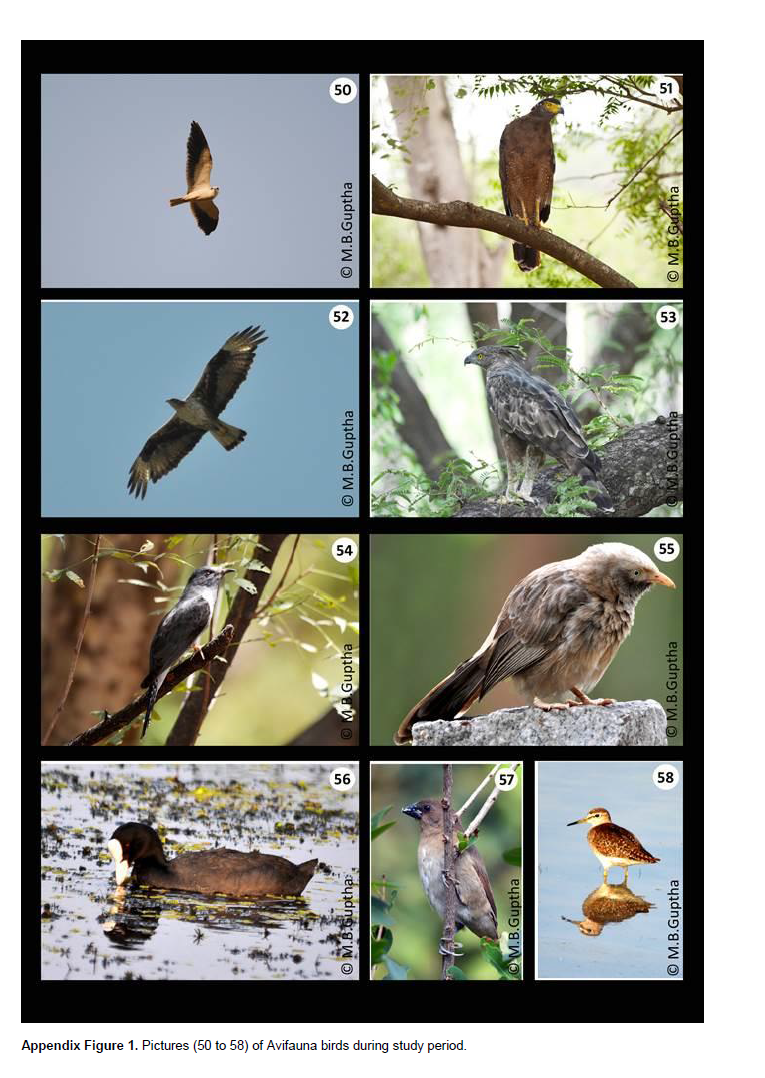ABSTRACT
The Seshachalam hill is the first declared biosphere reserve in Andhra Pradesh and is located in the southern Eastern Ghats of Chittoor and Kadapa districts. The vegetation comprises of a unique mix of the tropical southern dry mixed deciduous type. The study was carried out from August 2011 to February 2014. The study recorded 215 species of birds, which belong to 45 families. Among which 172 species (80%) were resident, 30 (14%) winter migrant, 8 (4%) seasonal local migrant and 5 (2%) and local migrant. 88 species were found common (C); followed by 91 species uncommon (UC); 15 species rare (R); 14 species occasional (O) and 7 species were found very rare (VR). Passeriform birds are the dominating order of birds, more than 14 families and 79 species of birds were recorded. During the bird survey IUCN status was also gathered, out of 215 species, (n = 208), 97% species were Least Concern (LR-lc), (n = 4), 2% species were Near Threatened (LR-nt) and (n = 3), 1% species were Vulnerable (VU) status. The findings of the present study underline the importance of Seshachalam Hills and also provide baseline data about birds in and around the reserve.
Key words: Birds diversity, abundance, status, seshachalam hills.
Abbreviation:
Very rare, (VR Least Concern (LR-lc); Threatened, (LR-nt uncommon (UC); 15 species rare, (R); 14 species occasional, O common (C); Resident, (R); Winter Migrant, (WM); Seasonal Local Migrant, (SLM); Local Migrant (LM)
Biodiversity is the total variety of life on earth (Rajendran et al., 2014) and also bird form an important component of the ecosystem (Rahul et al., 2014) as a part of food web, as potential pollinators and bio-indicators (Rudra, 2013). India has rich diversity of plants and animals both domesticated and wild in variety of habitats and ecosystem (Wanjari, 2013). The forests play a key role in maintaining a wide range of delicate relationship with nature and its ecosystem (Khaleel et al., 2014). The Indian subcontinent, a part of the vast Oriental biogeographic region, is very rich in biodiversity. Out of the more than 9,990 birds of the world, the Indian subcontinent contains about, 1,340 species of birds which contribute more than 15% of the world’s bird species (Anula, 2015). In Andhra Pradesh more than 500 species of birds were recorded (Taher and Pittie, 1989).
Sri Venkateswara Wildlife Sanctuary has a record of 178 species of birds (Anand, 2000) before it was declared as biosphere reserve. After 22 years, a study was conducted on birds in this region and 75 birds species were added to the previous list. Very little information is available on the avifauna of Andhra Pradesh through the work done by and Kinner (1930-37) on the vernay scientific survey of the Eastern Ghats and the Hyderabad state ornithology Survey (Ali, 1933-34). Later work was done by Hussain (1976), Shahid Ali (1976-83), Beehler (1985) and Anand Mohan (2000). These were mostly restricted to the northern part of Eastern Ghats in Andhra Pradesh and a few other patches in the state, so far there is no scientific study in this reserve (Anand Mohan, 2000). In the present study, attempt was made to prepare a comprehensive checklist of the birds of Seshachalam Hills and adjoining areas.
Study area
The Seshachalam biosphere reserve has been designated recently in 2011; these hill ranges are a part of the eastern Ghats and lie between 13°38’ E and 13°55’N latitudes and 79°07’ and 79°24’E longitudes spread over 4755.997 Km2 in Chittoor and Kadapah dis-tricts of Andhra Pradesh (Map 1). The elevation ranges from 150 to 1,130 m, the terrain is undulating, with deep forest-covered valleys. The maximum temperature ranges from 16 to 46°C and minimum from 9.7 to 25°C depending upon the season. Average rainfall in this region is between 800 to 900 mm. Most of the rainfall is received from the northeast monsoon and a little from the South-west monsoon. The vegetation is a unique mix of the tropical southern dry mixed deciduous type (Champion and Seth, 1968). It is the richest floristic hot spot harbouring many endemic and rare plants. The entire sanctuary is an uninhabited large chunk of dry deciduous, especially Red Sanders (Pterocarpus santalinus) bearing forest, forming catchments to Swarnamukhi and Pennar rivers, both in Chittoor and Kadapa districts. Seshachalam biosphere reserve includes, Sri Venkateswara Wildlife Sanctuary and Sri Venkateswara National Park (Map 1).
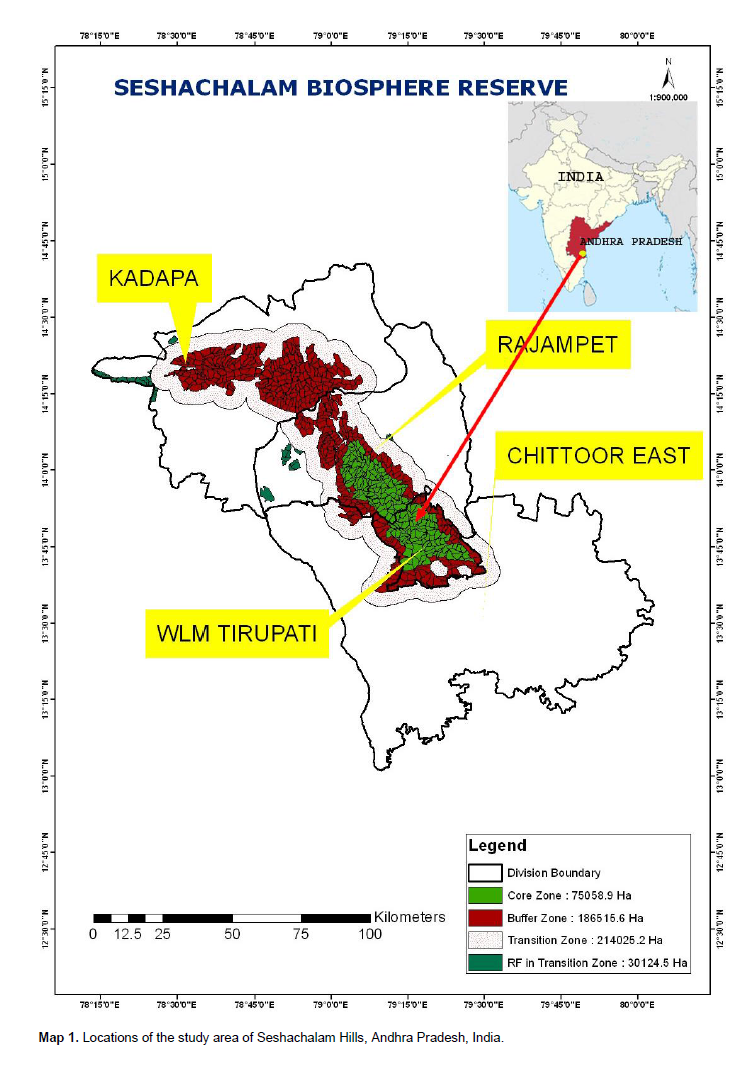
The study was conducted for the two and half years from August 2011 to February 2014 using direct visual count. Existing forest trails were used to conduct the study on foot (Lankar et al., 2010). The surveys were usually made in the early morning (07:00 to 10:30 h) and evening (16: 00 to 18:00 h), and also sometime night for nocturnal species like, owls and nightjars. Observation was carried out with the help of (8X40) binocular and photography was done with Nikon SLR camera with 150 to 500 mm zoom lens. The identification of birds in the field was based on Ali (2002) and Grimmett et al. (2011), and nomenclature and classification is followed according to Manakadan and Pittie (2001). The following field stations were monitored for avifauna. Water birds, this includes, Mamandur village tank, Settikunta village tank, Karakambadi tank, Kalyani dam, K.P.dam, Sidhala kanti tank. Terrestrial birds survey were monitored areas like, Jungle book (2 Km radius), Mamandur (8 Km radius), Balapalli (6 Km radius), Kangimadugu (3 Km radius), Tirumala (8 Km radius), Chamala (8 km radius) and Talakona (7 Km radius). Status of abundance and status of bird’s classification was followed on (Anil Mahajan et al., 2012).
Status and abundance
C- Common- (50 to 100) times; UC- Uncommon- (25 to 50 times); O- Occasional – (15 to 20 times) and seen occasionally in the study area; R- Rare- Seen only five times or maximum seven times; VR- Very Rare- Seen only once or twice.
Status of birds was classified as
i) R- Resident- which are found in the study area throughout the year.
ii) WM- Winter Migrant- which are found in the study area only during winter.
iii) LM- Local Migrant- which are found in the study area irregularly, but is resident of India.
iv) SLM- Seasonal Migrant- which are found in particular season only, but is resident of India.
A total of 215 species belonging to 17 orders and 45 families were recorded from Seshachalam Hills and its surrounding wetlands (Table 1). Of the total birds, 141 (66%) species of non-breeding and 74 (34%) species of breeding were recorded during our survey. According to the IUCN red list 97% (n = 208) species were listed as least concern (LR-lc), (n = 4) 2% species were Near Threatened (LR-nt) and (n = 3) 1% species were Vulnerable (VU) (Figure 1). Accipitridae was the most dominant family with 19 species (9%), followed by Muscicapidae 18 species (8%), Scolopacidae 13 species (6%) and Corvidae 13 species (6%) were recorded. The birds were categorized as Common (C) 41% (n = 88 species), Uncommon (UC) 42% (n = 91 species), Occasional (O) 7 % (n = 14 species), Rare (R) 7% (n = 15 species) and Very Rare (VR) 3% (n = 7 species) (Figure 2).
Among the total species observed, 172 (80%) species are Resident (R), 30 (14 %) Winter Migrant (WM), 8 (4%) Seasonal Local Migrant (SLM) and 5 (2%) Local Migrant (LM) (Figure 3). The present study recorded 215 species of birds belonging to 45 families. Nearly 85 species of wetland birds and migratory winter visitors. The main season for winter visitors is from September to February. In present survey reports four Near Threatened bird species namely Painted Stork (Mycteria leucocephala), Darter (Anhinga rufa), Pallid Harrier (Circus macrourus), Alexandrine Parakeet (Psittacula eupatria) and three species like Greater
Spotted Eagle (Aquilla clanga), Yellow throated Bulbul (Pycnonotus xantholaemus) and Yellow eyed babbler (Chrysomma sinense) were vulnerable category. Yellow throated Bulbul highest number 14 individuals were sighted in Talakona areas near to Waterfalls followed by 5 individuals in Jungle book 4 Kms away from Tirupati city, eight individuals from Tirumala, two individuals from Mamandur and 1 individual from Balapalli. The globally threatened Yellow throated Bulbul overall 38 individuals were recorded during our study period.
However, in the study we recorded some rare species like, Great cormorant, Darter, Black Ibis, Spotted Eagle, Created serpent Eagle, Black Eagle, European march harrier, Osprey, Yellow wattled laping, Jungle owlet, Brown Hawk owl, Yellow Browed Bulbul and Spotted Babbler are less in numbers during our field visit. Seven species of birds were very rarely recorded during the study period, that is, Booted Eagle, Bonelli’s Eagle, Pompadour Green Pigeon, Alexandrine Parakeet, Indian Grey Hornbill and Great Racket- tailed Drongo. Earlier from 1991 to 1994, 178 species of birds belonging to 49 families were recorded in the same area (Anand Mohan, 2000), Manjeera Wildlife Sanctuary 164 species to 53 families (Prasad et al., 2014), Nallamala Hills 302 birds (Srinivasalu and Nagalu, 2001), 125 species of land birds in species of water birds in Pulicat (Kannan et al., 2008), 99 species in Thummalapalle uranium mining (Reddy et al., 2014) and 37 species in Nelapattu (Guptha et al., 2011) were recorded.
Compared with present study 75 species of birds were additionally recorded and 40 species of birds had disappeared. It shows great avian biodiversity which can attract the attention of bird watchers and ornithologists (Appendix Table 1 and Appendix Figure 1).
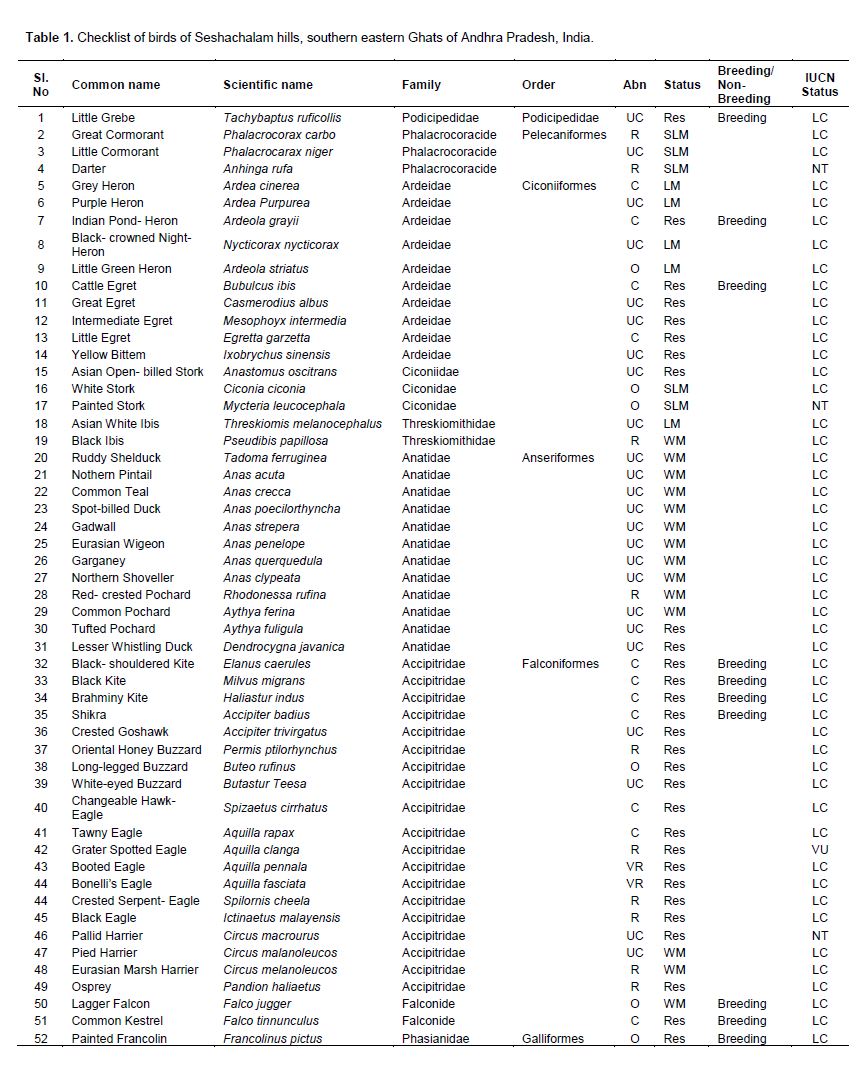
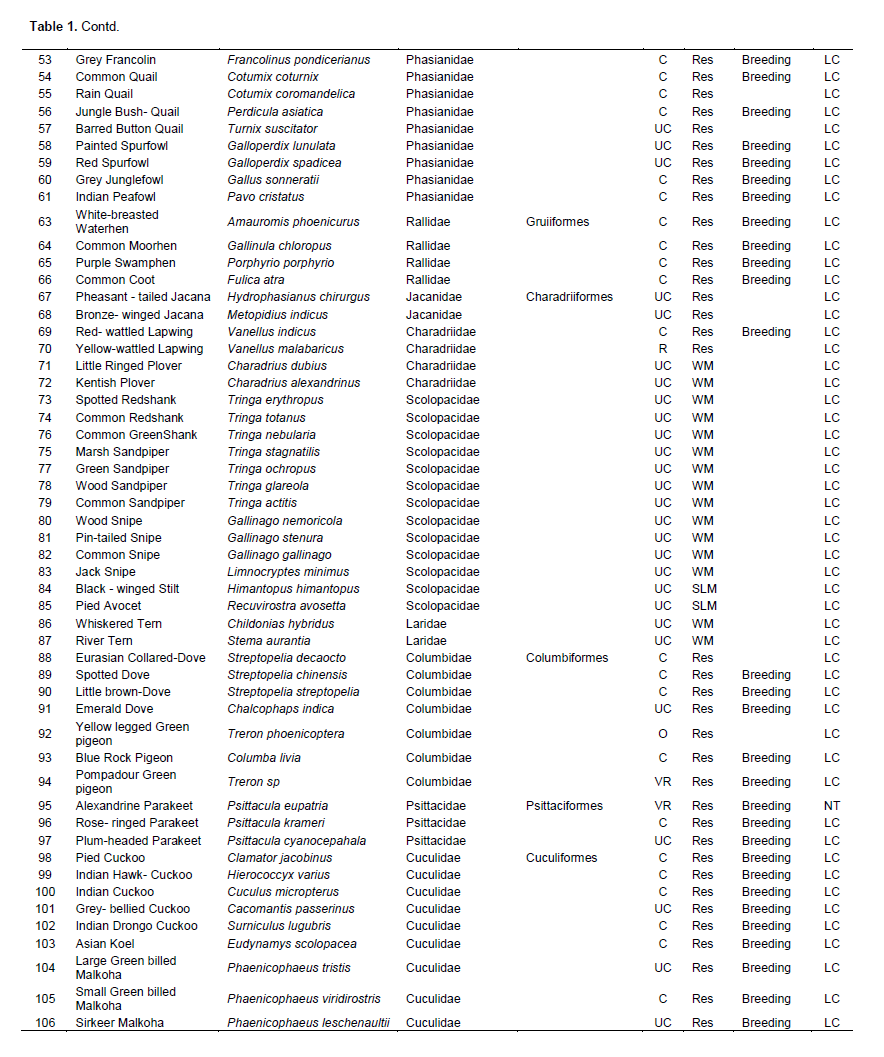
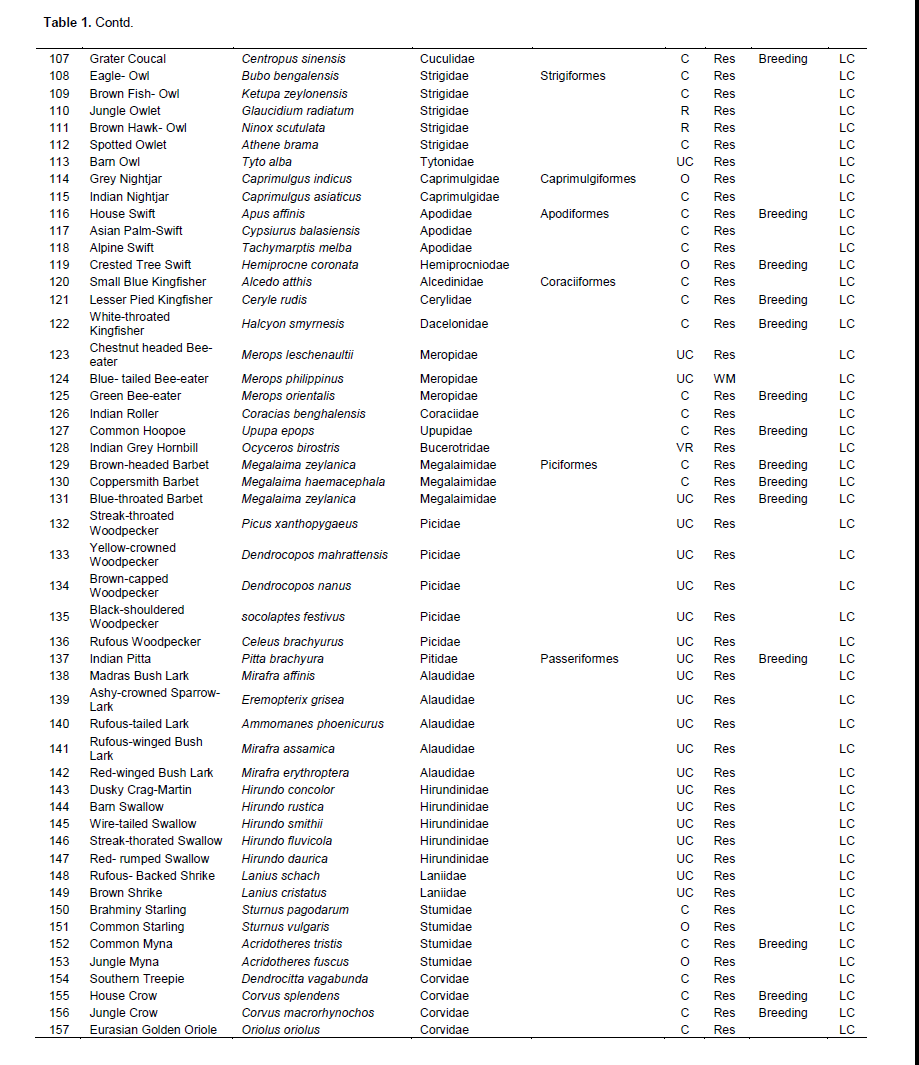



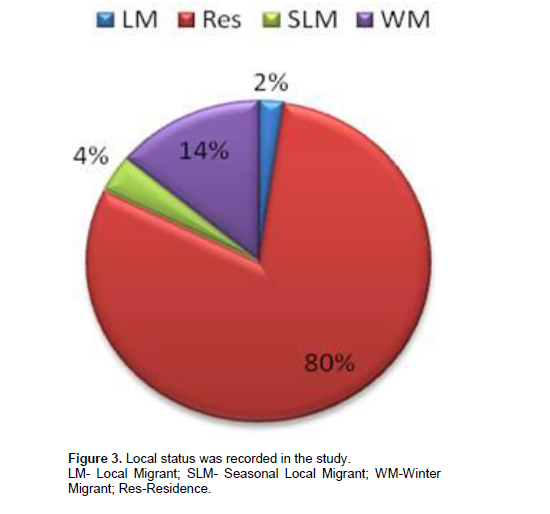
Threats
The Seshachalam is under severe threats due to habitat destruction, livestock pressure mostly in Kalyani dam and Pulibonu areas. Forest fire is the major threats in the study area. Management interventions ensure checking of illegal entry, livestock pressure and illegal logging mostly in Red sanders (Pterocarpus santalinus) trees.
Future issues
Further research with reference to habitat studies, threats and conservation of Avifauna in the area is in progress. Several species came under schedule act and globally threatened and there is an urgent need to adapt conservation policies and everyone should realize that the protection of habitat is an importance aspect in conservation of such species.
The authors declare that there is no conflict of interest
We are grateful to the Andhra Forest Department specially Sri A.V. Joseph, IFS Principal Chief Conservator of Forests and Head of Forest Force (HoFF), Andhra Pradesh for their co-operation and permission to carry out field studies in Seshachalam Biosphere Reserve. We thank Mr. Dipankar Lahkar for necessary correction and comments and Mrs Ch. Deepa, Forest Range Officer (GIS) for sharing map and encouragement. Also, thanks to Sri T. Thulasaiah, Sri K. Madhu, Miss K. Rohini Anusha, Sri V. Bhavani Shankar, Sri G. Uma Maheswar and Sri P. Prudhvi Raj from Bio-Lab of Seshachalam Hills for necessary help and to Mrs Vamsee Priya for suggestions and comments. Finally, we thank all forest staff from SV National Park, who accompanied along with the survey.
Abbreviations: Very rare, (VR Least Concern (LR-lc); Threatened, (LR-nt uncommon (UC); 15 species rare, (R); 14 species occasional, O common (C); Resident, (R); Winter Migrant, (WM); Seasonal Local Migrant, (SLM); Local Migrant (LM)
REFERENCES
|
Ali S, Ripley SD (1976-83). A Pictorial guide to the birds of the Indian Subcontinent. Oxford University Press, New Delhi. 177pp.
|
|
|
|
Ali S (2002). The Book of Indian Birds. (13th Edn.). J. Bombay Natural History Society, Mumbai.
crossref
|
|
|
|
Anand MB (2000). Birds in and Sri Venkateswara Sanctuary, Andhra Pradesh. Zoo's Print J. 15(10):339-343.
crossref
|
|
|
|
Anil M, Padmakar L, Vijay I, Manohar K, Raju K, Jayant W (2012). Checklist of birds of Mahendri Reserve Forest, Amravati, Maharashtra". Newslett. Birdwatcher 52(2).
|
|
|
|
Anula J (2015). Studies on the Status of the birds Inhabitating Sirpur Lake Indore, MP, with Reference to the Changing Environment. Res. J. Recent Sci. 4(IYSC-2015):18-21.
|
|
|
|
Champion HG, Seth SK (1968). A revised survey of the forest types of India". Govt.of India Press, Delhi.
|
|
|
|
Grimmett R, Inskipp C, Inskipp T (2011). Birds of the Indian subcontinent. Oxford University Press, New Delhi.
|
|
|
|
Guptha BM, Chalapathi Rao PV, Ramlingam G, Prasad PN, Kishore S, Rajasekar M (2011). The water birds of Nelapattu Bird Sanctuary, Andhra Pradesh, India. World J. Zool. 6 (3): 249- 254.
|
|
|
|
Hussain SA, Panday JD, Shekar PB (1976). Extension of range of the large Yellownaped Woodpecker (picus flavinucha flavinucha Gould). J. Bombay Natural History Soc. 73(2):394.
|
|
|
|
Kannan V, Manakadan R, Prakash Rao, Mohapara KK, Sivakumar S, Santharam V (2008). The waterbirds of pulicat lake, Andhra Pradesh-Tamil Nadu, india, including those of the adjoining wetlands and heronries. J. Bombay Natural History Soc. 105(2).
|
|
|
|
Khaleel BS, Niaz Parveen D, Gopi Krishna S, Sudarsanam G (2014). Impacts of climate change on Yerramalais forest of Eastern Ghats of Kurnool District, Andhra Pradesh, India and options for adaptation. Intl. J. Biodiv. Conserv. 6(3): 210-216.
crossref
|
|
|
|
Manakadan R, Pittie A (2001). Standardised common and scientific names of the birds of the Indian subcontinent. ENVIS Newslett. 6(1):I – ix, 1-37.
|
|
|
|
Manakadan R, Prakash Rao, Mahapatra KK, Sivakumar S, David PJ, Senthil MB, Santharam V (2009). The land birds of Sriharikota Island, Southern India and conservation Issues. J. Bombay Natural History 106(1).
|
|
|
|
Prasad KK, Ramakrishna B, Srinivasulu C, Srinivasulu B (2014). Avifaunal diversity of Manjeera Wildlife Sanctuary, Andhra Pradesh, India. J. Threat. Taxa 6(2):5464–5477.
crossref
|
|
|
|
Rajendran A, Aravindhan V, Sarvalingam A (2014). Biodiversity of the Bharathiar University Campus, India: A floristic approach. Int. J. Biodivers. Conserv. 6(4):308-319.
crossref
|
|
|
|
Rahul K, Rajesh Manhas, Samriti Aggrwal, Sahi DN (2014). Birds of Srinagar City, Jammu and Kashmir, India. Intl. J. Biodiv. Conserv. 6(3):210-216, 6(3):217-221.
|
|
|
|
Reddy YA, Sadasivaiah B, Rajakullaiswamy K, Indira P, Pullaiah T (2014). Avifauna of Thummalapalle Uranium mining area, Andhra Pradesh, India. J. Threat taxa 6(12): 6556-6565.
|
|
|
|
Rudra NP, Udit Pratap D, Rajesh KM, Arun KM (2013). Checklist of Birds in and Around Ansupa Lake, Odisha, India. Intl. Res. J. Environ. Sci. 2(11):9-12.
|
|
|
|
Srinivasalu C, Nagalu V (2001). Mammalian and avian diversity of the Nallamala hills, Andhra Pradesh. Zoos' print J. 17(1):675-684.
crossref
|
|
|
|
Taher S, Pittie A (1989). A Checklist of Birds of Andhra Pradesh, published by the Authors, Hyderabad. Ix + 39 pp.
|
|
|
|
Wanjari AJ, Pawar SS, Patil KG (2013). Birds of Tipeshwar Wildlife Sanctuary, Maharashtra, India. Int. Res. J. Sci. Eng. 1(3):79-84
|
|
|
|
Whistler H, Kinnear NB (1930-37). The Vernay Scientific Survey of the Eastern Ghats – Ornithological Section (16 Parts). J. Bombay Nat. History Soc. 36-39; 720-735; 505-524; 67-93; 96-105; 418-437.
|
APPENDIX
